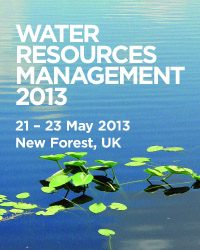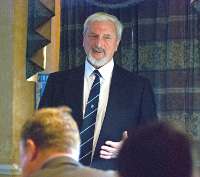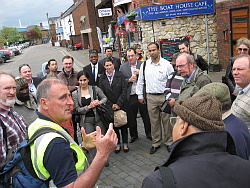7th International Conference on Sustainable Water Resources Management
New Forest, UK
Overview

The 7th International Conference on Sustainable Water Resources Management was recently held in the New Forest, UK, home of the Wessex Institute of Technology, sponsored by the WIT Transactions on Ecology and the Environment and the International Journal of Sustainable Development and Planning.
The Conference aims to develop better management tools to predict future trends and propose appropriate sustainable solutions.
The need to provide sufficient water to satisfy the requirements of a growing population results in considerable strains on the availability of those resources. The problem is aggravated by human activities affecting water quality, as well as by inadequate distribution. Climate changes and natural disasters compound the uncertainties surrounding the optimal management of increasing scarce water resources.
The first of these meetings was held in Halkidiki, Greece in 2001, followed by another in Las Palmas, Gran Canaria (2003); a third in the Algarve, Portugal (2005); the fourth in Kos, Greece (2007); the fifth in Malta (2009); and the previous one in Riverside, California (2011). Papers presented at those meetings as well as this conference are permanently available to the international scientific community in digital format at http://library.witpress.com.

Conferences and courses, Carlos explained, are not the only activities of WIT, but they are of fundamental importance. The Institute organises a series of short courses, many of them focused towards industry. The conferences themselves bring together colleagues from around the world.
The Conference books are published by WIT Press and archived in the WIT Transactions which are included in many databases, including Scopus. The volumes, as well as other books published by WIT Press, are widely distributed throughout the world, in digital as well as paper format, ensuring that the work presented at WIT Conferences receives the maximum dissemination.
Carlos explained that the research carried out at the Institute focuses on boundary element modelling, a technique developed over the years by his research group, and by which WIT is renowned throughout the world. The software resulting from this research is widely applied for the solution of a variety of practical problems, particularly in the energy and aerospace industries. These activities continue to increase, which is rewarding in terms of validating the importance of this research in practice.

WIT is keen to continue to interact with other institutions around the world and welcome any new enquiries in this regard.
Carlos concluded his introductory remarks by thanking the delegates for coming, wishing the conference all success. He was delighted that the Conference took place in the New Forest, so that they could get a better appreciation of the work carried out by WIT.
The Conference was characterised by its friendly atmosphere and lively discussions which took place during the breaks and social functions, as well as during the formal sessions.
Conference Topics
The papers presented during the meeting were grouped into the following topics:
- Water management and planning
- Water policies
- Urban water management
- Water quality
- Flood risk
- Hydraulic engineering
Invited Presentations
There were a series of invited lectures by well known colleagues, which helped to enhance the meeting, ie:
“Stakeholder participation in flood control of Ciliwung river, Jakarta, Indonesia”, by Amos Neolaka, State University of Jakarta, Indonesia
“Using maximum entropy for discharge calculation in open channel flow”, by Viktor Diniz, Unicamp, Brazil
“Settlement mechanisms of international water disputes” by Paulo Canelas de Castro, University of Macau, China
“The smart grid as a public health protection tool, using smart grid technologies for monitoring distribution systems” by Graham Symmonds, Global Water Resources, USA
“Sustainable solutions for cost effective rainwater harvesting in Nepal: pilot project STORAGE realised in Kathmandu valley, Patan”, by Zuzana Boukalova, Nodni Zdroje, Czech Republic.
Excursion

Lymington is now a vibrant and prosperous town, with many of the residents keen sailors and a large number of picturesque old houses.
Conference Dinner and BBQ

Following the death of the original owners, the house fell into disrepair, from time to time being used for functions, training and other similar activities. It was eventually turned into a hotel and is now well established and renowned for the excellence of the service and its cuisine.
The main course consisted of lamb, a speciality of Hampshire at this time of the year, accompanied by good wines and taken in a friendly environment.
At the end of the meal, Carlos thanked the delegates for coming to the New Forest conferences and talked about the history of Rhinefield House as well as Ashurst Lodge, home of the Wessex Institute of Technology. He concluded by saying how rewarding he always finds it to welcome delegates from so many different countries at the WIT conferences. We were fortunate to benefit from such a wide variety of cultural diversity as well as scientific excellence.

Delegates were also offered the possibility of having a look around the Institute main building, and in particular Carlos’ office, where he explained the history behind some of the many souvenirs that he has collected around the world.
The meeting was most successful and will help the delegates to strengthen their links to the Wessex Institute.
Conference Proceedings
The proceedings of Water Resources Management 2013 -Water Resources Management VII, 272pp (Print ISBN: 978-1-84564-710-0; eISBN: 978-1-84564-711-7) are available from WIT Press. Orders can be placed on the WIT Press web site at www.witpress.com or by email:
Papers from the conference will also be hosted online at the WIT eLibrary as Volume 171 of WIT Transactions on the Ecology and the Environment (ISSN: 1746-448X, Digital ISSN 1743-3541). For more details visit the WIT eLibrary at http://library.witpress.com


 Wessex Institute
Wessex Institute